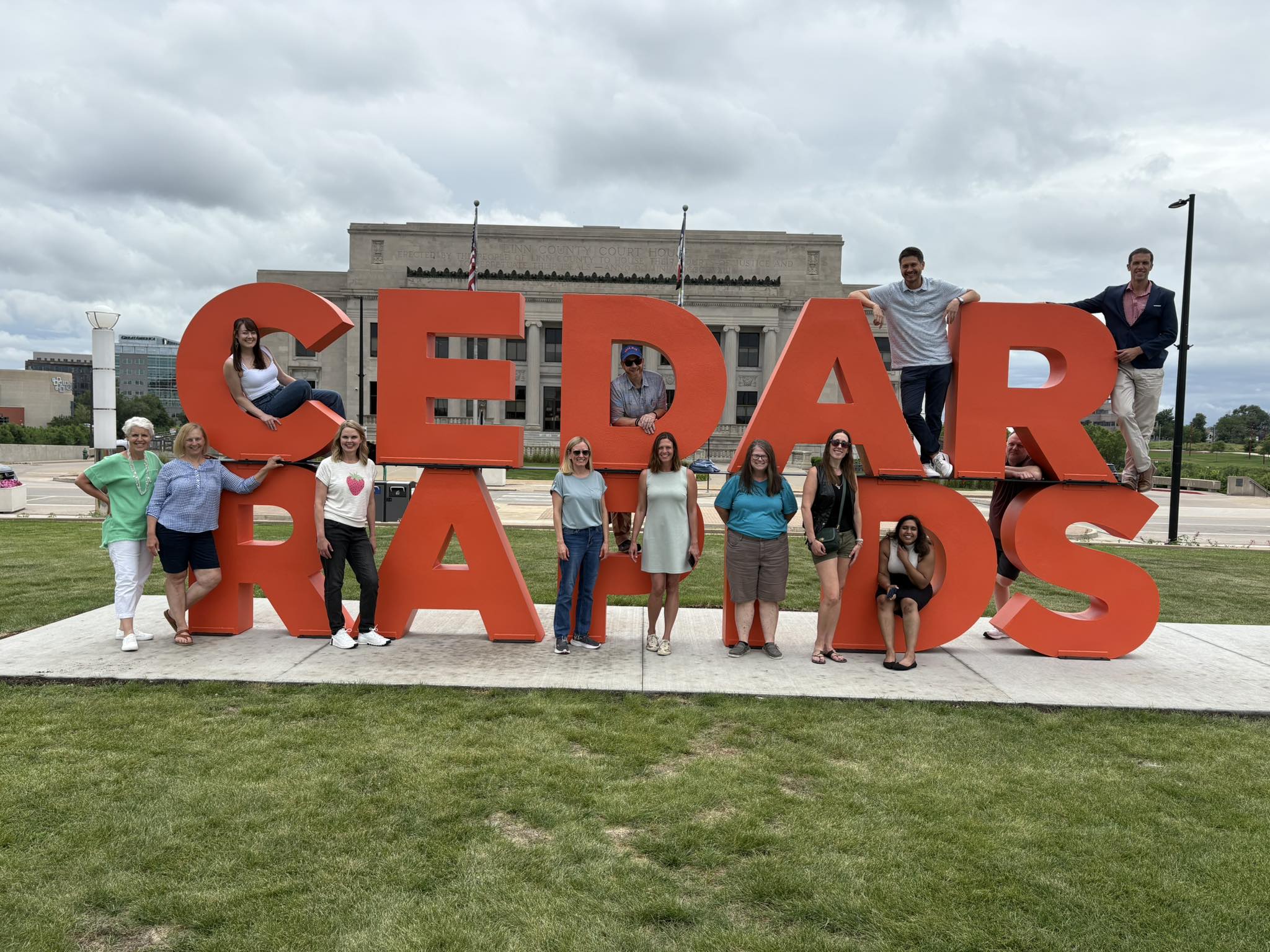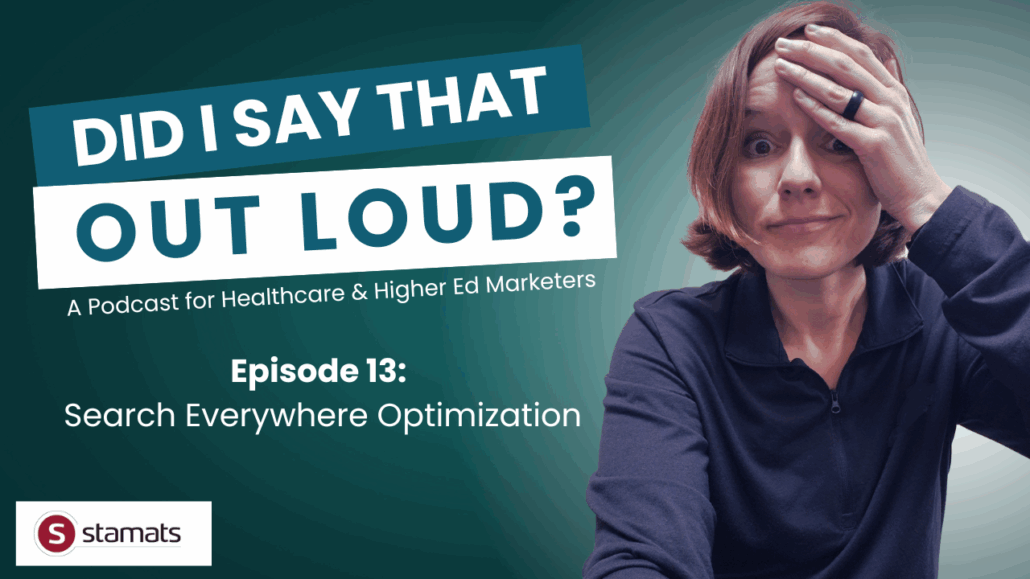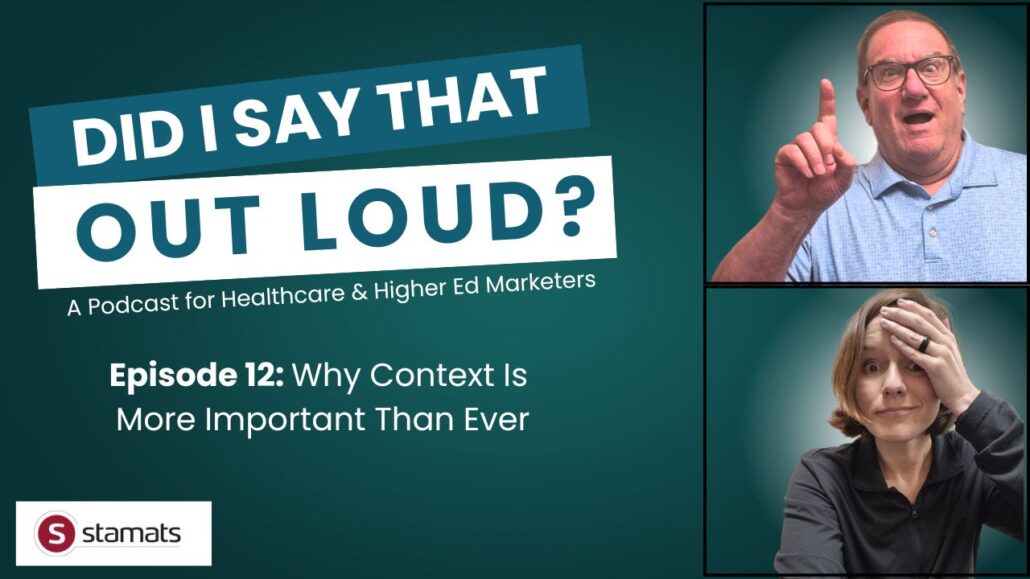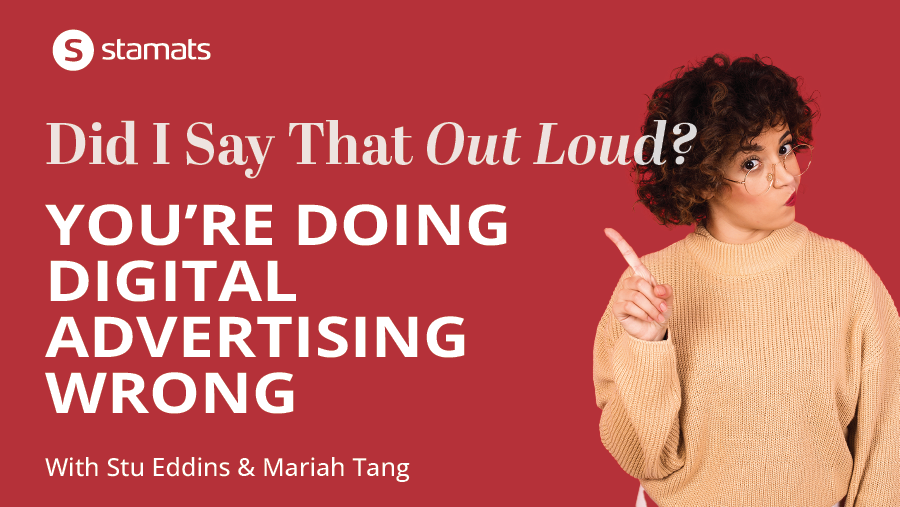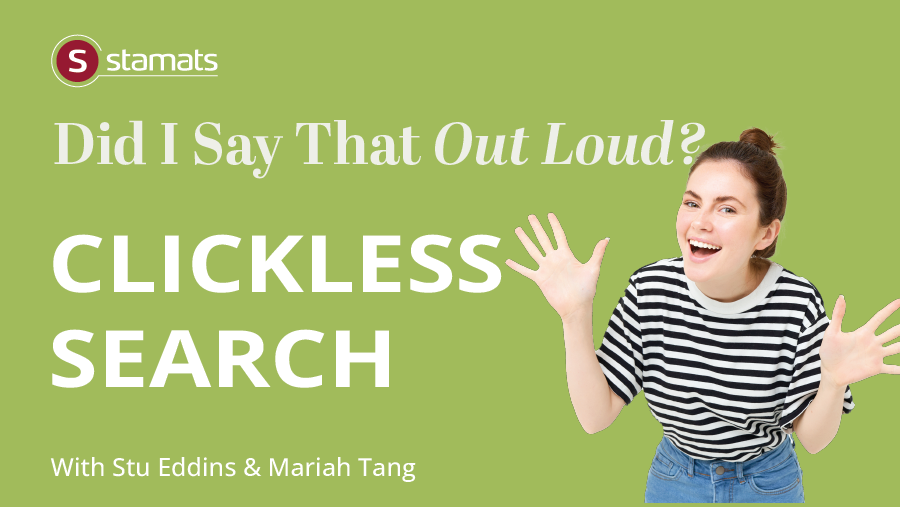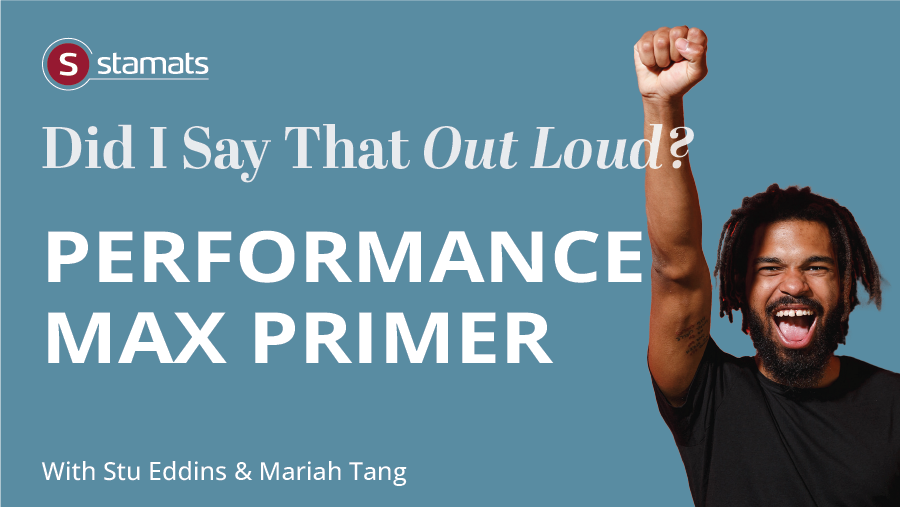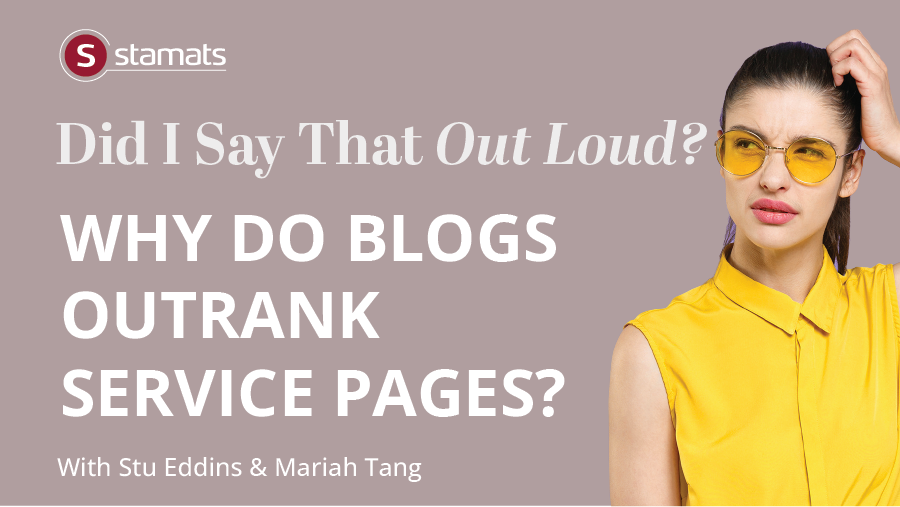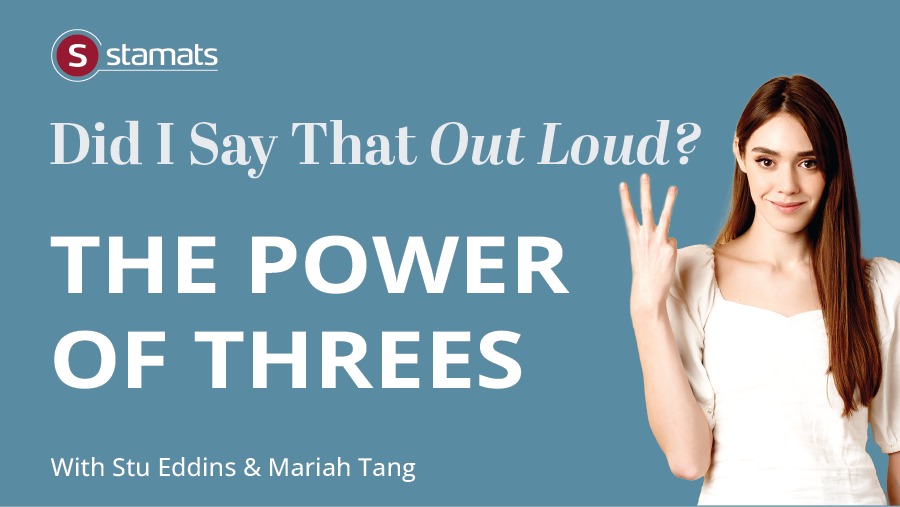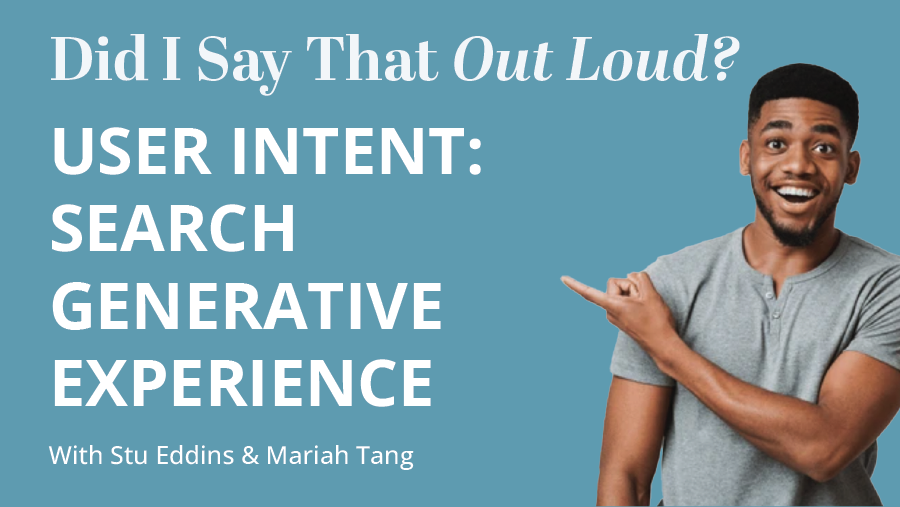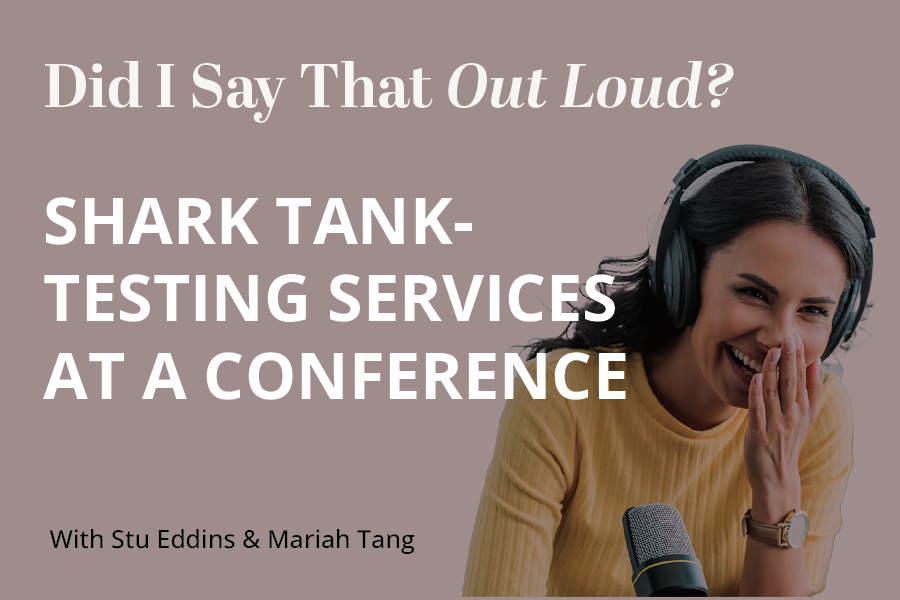Remote work is amazing. But you know what’s better? Bringing all our Stamatians to Cedar Rapids, Iowa, for a team onsite. Stu and Mariah talk about screaming monkey boomerangs, our impressively tall colleagues, and the enthusiastic creativity that will bubble up to our clients.

June 1st, 2025
Season 1, Episode 14
Remote work is amazing. But you know what’s better? Bringing all our Stamatians to Cedar Rapids, Iowa, for a team onsite. Stu and Mariah talk about screaming monkey boomerangs, our impressively tall colleagues, and the enthusiastic creativity that will bubble up to our clients.
Listen to Episode
Show Notes
Transcript
Mariah Tang: Did I say that out loud? Welcome to “Did I Say that Out Loud?”, a podcast where Stu Eddins and Mariah Tang reflect on agency life and answer questions from our higher ed and healthcare clients about the latest in digital marketing, content and SEO.
Stu Eddins: One thing we thought to talk about today, departure from marketing and departure from all the digital stuff that tends to inundate our lives. We thought we’d talk about what just happened at Stamats this last week, we had an in person retreat for everybody who works at our company, we all showed up at world headquarters here in Cedar Rapids, Iowa.
Mariah: Eventually.
Stu: Eventually, that’s true. That’s true. Well, that isn’t, that isn’t to say that there, there hadn’t been trouble and strife in getting here. Certainly was one of our teammates, Lisa, in fact, was prompt. She got up, got to the airport at 3am and time to figure out her flight had been canceled or some such thing. But any rate, it took some effort. We all got here, and it was interesting. A lot of the folks who were under this roof had worked together for years, and it was a time to kind of rekindle some friendships and acquaintanceships. But we also had a number of new people, people who had never really been person to person, even with the person who interviewed them before they got the job. That was the first What do you think I count at least five people for who that was?
Mariah: Yeah, at least five. Yes, five. And one of our senior writers, Chris, had actually, we’ve worked together for about five years, and I’d only met him in person one time, so that was kind of fun. Yeah, for the second meeting. And I’m always impressed with how tall people are in person. Yeah, you see people from the the rib cage up all the time. Yeah, people are impressively tall here. Got that going for us?
Stu: Yeah, we win by height. The other thing that kind of occurred to me is the people did fall into talking to each other, talking to each other fairly, in a fairly natural way. The ice didn’t need to be broken that much. And that includes our administrative team and our accounting team and our HR folks, and just everybody. It was, it was really cool to see everybody kind of gel together, from sales to support to execution, virtually everybody was here. The thing that I found interesting was that it appeared that most of the new people, if you will, quickly settled into the group. It’s not because there was the warm opening arms, welcoming everybody in. There was there was that, but it was because there had been relationships established before they showed up. Yeah, even if it had only been a couple of weeks that there were, there are people to touch base with, and actually shake a hand and so on. But what I’d like to kind of get to is some of the benefits that I saw happen beyond the agenda. Now let’s talk about that agenda for just a moment.
Though we tried to have a jam-packed meeting, because, let’s face it, we essentially shut down business for three days, which has cost. We flew everybody in, we put them up at a hotel room, and by the way, we fed them along the way too. There was cost involved with this. So we did have an agenda. There were things we wanted to accomplish. We wanted to make sure that we use the brain power we have in a unique way, and we’ll talk about that a little bit. We wanted to make sure that that we got a bullet list of tasks done, some of which were immediate payoffs, such as discussing how we’re going to talk to clients about performance or future, how are we going to get together as groups and solve some problems. So we did have an agenda stretch out.
We also wanted to take the opportunity to have some opportunity for self improvement along the way. Chris Rapozo gave a great keynote on personal brand. And again, we’ll talk about that too. But in between all those moments is really kind of the interesting part. I spent some time watching and observing, and what I saw that interested me the most. It’s as though we crammed a year’s worth of important hallway conversations into three days.
Mariah: Yeah, you just don’t get that same water cooler effect when you’re all remote. It’s easy to just, well, you. When I in the office all the time, so you can pop into my office, I pop into yours and harass you every day, and you just, it’s different. You can’t just ping someone and be like, Hey, dude, what’s up, and then you wait five minutes for them to see it. It’s a little different. Yeah, yeah.
Stu: But at the same time, having had those distant, electronic connections, I think is part of what made it easier person to person. Yeah, yeah, totally.
Mariah: I think there’s always something lost in translation. Like me, I’m a very scatterbrained person, as you know, after working together for 10 years or so, I jump from thing to thing, and it’s a way different to type from thing to thing, because you sound kind of cranky. But in person, it’s like, Hey, man, yeah, you’re bouncing all over the room, and people are like, Oh, is this what you meant when you typed that thing two weeks ago? Yes, yes, it is.
Stu: By the way, we don’t consider it scatterbrained. We consider it enthusiastically creative. But yes, I get that, and I think the fuel behind some of this was curiosity, the electronic communication we have it after a while, as much as you may feel you know the person, you still at some point, think of them as an as an avatar, or this little two inch video insert in your life, and having had the experience of working back and forth, even remotely through electronics, that was kind of the icebreaker, in most cases, getting to face someone and talk to them one on one introduced something else. And it wasn’t personality, it was communication style, and that’s really important. Here’s something I found interesting, and I was thinking that this morning, as I was getting ready to talk this through with you, several years ago, I was in a different office, different industry altogether, and I watched two people who sat back to back with 15 feet of empty space between them have a five minute exchange over text messaging.
Now my kids, but you know, I watched one person, type, type, type, type, type, and then I heard ding on the other computer when it came in. Look at it respond, think about it for a moment. Type, type, type, okay. The setup is silly. I mean, if they just turn their chairs 180 degrees and talk to each other five minutes, could have taken place in 90 in 90 seconds. But one thing it did bring up, and this is where electronic communication, I think, dilutes our relationships. We contemplate, we self edit. We have an opportunity to say, oh, Backspace, erase, erase, erase, erase. That’s not what I meant. I meant to say this. And sometimes I think what happens is we neuter our conversation, we subtract emphasis, or we exchange emphasis that we feel for one that seems more appropriate.
Mariah: Yeah. It’s sometimes the opposite, if they need to unto something and like, if I was in person, maybe I would have sat with that for a minute, yeah, not to let my face look so grumpy. I’m really not that grumpy everyone. I swear.
Stu: No, she’s not. Maybe.
Mariah: Oh, careful, because we’re in person!
Stu: That’s right. Oh, our self-image gets in the way. But the the other part about it is, is we’ve always known that communication is largely visual as well being able to read the body language of somebody. Yes, you have a video call, you’re seeing the rib cage and up two inches taller full screen, if you’re one on one, doesn’t matter what you’re not seeing is what you’re not seeing is what they’re doing with their hands. You’re not seeing how they shift their feet as they get impatient. You’re not seeing all the things that cue people to say, let’s get to the point and get it done, or the encouraging ones leaning in. We even have that as a phrase, leaning into something, and that’s kind of lost on video, because we’re shifting around in our seat all the time, but we first, if we’re face to face, having conversation, and it becomes more connected, more enthusiastic, we do literally lean in, which encourages the other person to keep going. It is subtle. It’s been body language has been studied to death, and will continue to be for ages to come.
But getting everybody together in one place, suddenly, we renegotiate those relationships a little bit. It’s not with each other, it’s within ourselves. For example, I was talking to somebody that I really don’t have a lot of connection with, Chris, you were speaking of, and we actually had some aside, conversations not work related at all, but we I caught myself leaning in a little more to talk to him, which encouraged him to talk back to me. Not a major thing, not a big thing. Maybe it would make him feel more comfortable talking to me digitally. Yeah. So that’s some of. Benefit. Now we can talk about personal and soft benefits and so on and but the real outcome of was, in many cases, the conversation topics may have been more work related, but we were able to communicate quickly where we stand on a topic. And I think that that was that, that was what I was talking when I said a year’s worth of Hallway Conversations inside of three days, yeah, and I saw people slightly eager to have those conversations. It’s like, I need to talk to this person. I’m going to make sure I have one on one time with them, at least for, you know, half a heartbeat.
Mariah: Yeah, it was kind of interesting. Like a few years ago, we did the same thing with just one of the teams. We had the project managers only come in. And I feel like that was more intensive. There was much stricter agenda. We really had a lot of, okay, these people need to talk with these people. And kind of shifted people around. This was a lot more organic. And I think we as a leadership team, maybe expected to have to, like, herd people together a little more, like everybody come to the front, you know, fill in these seats, or you guys sit over here with these, these folks over here. But they really mix themselves together organically very well.
We had people clamoring to get up front so they could see their coworkers present and things like that. So it was, it was really inspiring. It’s easy to kind of feel like, especially, I think in a leadership position, kind of feel like, what are we going to do next? Everybody’s so maxed out, you know, who’s going to work on this coming project? It’s everybody really is confident as they’re saying they are about that. Then you see it in action, and it’s really validating.
Stu: It is, there’s, there’s also a potential for something else to happen when you get to meet somebody face to face, when you’re having that, the moment you have during these, these in services, retreats, whatever you want to call them, it can also renew that commitment to not let that person down. Yeah, it’s a personal accountability issue. It’s not like Mariah, you and I met at the conference after not seeing each other for a year, and I got it’s like, you know, I gotta remember from these conversations that Mariah isn’t just a taskmaster sending me stuff to do, but I realized it’s the person that I’ve got to protect that relationship that’s there to make it more effective, to make her successful.
Mariah: I think that translates to our clients too. Yes. You know, in in the olden days, we used to go to client visits all the time when we would have blog interviews and things I’d slap on down to wherever the client was, bring all my recording equipment, sit with the doctors, sit with the faculty, whomever we were visiting with, and really have those face to face conversations. And then the pandemic hit, and all of that changed, and it just never changed back.
So, we’ve really made a concentrated effort over the last couple of years to get on site with, you know, clients, to have that face time, not just at conferences, but to really make time to do that for those same reasons. You know, like I’ve met some of the editors that I’ve worked with for years, and when you meet them in person, and you get to see all the other things they do besides just your little project, you really get a different perspective of all of the things, of all of the ways that they make time to make you feel like part of the team, and it really drives you to like, I’ve got to I’ve got to do this for Rick, I’ve got to do this for Valerie. I’ve got to do this for Amy, whatever.
Stu: Yeah, and we did have hard target things we wanted to get done, and that’s the agenda parts. But I think having the community time before each one of those things happened made people feel more comfortable in the exchange during those agenda items.
Mariah: Yeah, raising their opinions, giving their ideas, they weren’t going to be like, Wow, that’s stupid.
Stu: We had two needful breakout sessions. Pardon me, the first one was how to use Excel. Well, I I’m minimizing by saying it that way, but you know, it’s something of a let’s get reacquainted with Excel. It’s more than just a collection of columns, rows and numbers. Here’s how we use this thing.
Mariah: You mean it’s not just an editorial calendar? Yeah, that’s one of many uses.
Stu: Then we had another session on how we have our internal accountability to tasks. We use a card deck system for being accountable to the task we have to do. So there was a session on that, because that was like more of a sharpening the saw moment. If everybody knows what it was, in the beginning, we’ve drifted. Let’s get back together. Make sure we’re all on track. But the third one had absolutely nothing to do with business whatsoever. The third one was Eric out there teaching people how to take better pictures on their phone.
Mariah: The fourth one was Kris teaching people some ins and outs of Canva.
Stu: I think part of what made it successful was we were developing the company and the person at the same time. Yeah, then Chris Rapozo with a keynote on his on brand building.
Mariah: And yours on AI prompts and and how to create different things, different outcomes, using the same steps. That was really helpful for people.
Stu: Well, yeah, and honestly, I I tried to make sure it wasn’t work focused, because we used AI to plan a trip to Arizona, as you know, individual workshop type stuff. Some people decided to make it to the Black Hills. I think somebody decided to make it a trip to Hawaii and and then Google spat out what the airfare was, any rate. The thing that I was trying to observe, because I mentioned I did hold back, in some cases, stand in the corner, look at what’s going on. I’ve already noted the ease with which people assembled when they started coming together as a group, talking, exchanging, moving from one person to the next to talk and so on the comfort level, I’ve mentioned the interaction that happened during the the set piece breakout sessions.
One thing I’ll say this, I walked into the Excel event, one of them, because everybody rotated in just one of those meetings. So meetings, I noticed somebody asked a question that alone that normally I would have expected them to say, I’m embarrassed to ask this. But how about they weren’t embarrassed. They just asked the question they felt comfortable enough in front of their peer group to simply say, You know what? This should be basic. But I don’t know, help me. Yeah, and I think that that may have been a better learning moment for that person than being referred to a tutorial, or maybe even a one on one interaction with an instructor, because young people were there kind of support them as they were, as they were asking that, that, if you will, vulnerable question in front of their peers, yeah and no criticism.
So again, benefits that tend to be more relational than just the just rote. It wasn’t so much that it was just about learning how to how to work with Excel. We got that that was that was great, but it was also the the learning that you can ask the question just ask.
Mariah: It’s less intimidating to blurt something out, than to unmute your microphone, wait for your turn, say it in front of God knows who is on that meeting, and then just kind of wait for the tickets, yeah, to answer right, right.
Stu: Well, you know what? That’s the other part about it. When you’re live, it’s kind of hard to avoid answering, yeah, even in a group chat, even if you have a teams meeting going on, you got five people in there, and the person at the moment who has the mic steps up and asks the question. It’s easy for everybody else to say somebody else is going to go first. It’s more difficult to do that when everybody’s in the same room and everybody’s looking around saying, okay, who’s going to take this one? Because somebody’s got to step up and respond. So there’s a little bit of prompting that comes along from that, as well benefit again, overall, when I look at what we did, there was a, let’s face it, it was, it was a expensive thing to do.
But I also think the people that attended this walked away perhaps with the idea that it was, it was an investment more than an expense. Yeah, I’ve been part of some of these at other organizations that fell absolutely flat. They spent a lot of money. They got nothing for it. It was an expense. Yeah, I can remember one memorable one where we all went to Orlando, and that was where we had our meeting, because it was truly a nationwide company with several thousand employees, and they pulled in all the management people to Orlando, and it was regimented. And you had 15 minutes between sessions, and you moved from one to the and it did feel. It felt in no way organic. There was, there was, there was no moment other than the lunch break. They even planned dinners for us and after dinner entertainment, which means everybody’s focused on the entertainer. Instead of talking to each other, they blew it. They spent the money to fly in about 150 people to Orlando from across the country, choreographed every single moment, and everybody left knowing that they had an agenda, and that’s about it.
What we did, we’ll find fault with it. We’re going to have a postmortem on this and go through and say we should have done this better or that better, that that’s true. But what we did, and frankly, because most of us have matured from those points of the highly structured. We anticipated having the quiet moments in there for people to gather on their own.
Mariah: Plus, we have so many creatives that are introverts; ya gotta give those folks a break.
Stu: Yeah, yeah, no, nobody showed up wearing black, yeah, this wasn’t that type of a thing. But the other nature, yeah, by nature, a lot of people who are involved in marketing do tend to be introverts. I mean, I can stand up here and expound about anything you put in front of me. I can talk to groups of people, other stuff. It’s the one on one that gets a little rough. Yeah, that’s where the where the introverted part of me has a bit of a problem. But the other, the other benefit about this is we have stories that unite us now a little more.
We went to a ball game, and I don’t think anybody watched any batter that was up for more than, like, maybe a couple minutes, and that was it. It was a great way to have hot dogs and hamburgers pushed at us a beer, maybe a soft drink, and mill around on a very warm night while there’s a loudspeaker announcing something nobody paid attention to. Okay, there were people who paid attention to the game. Yeah, I was not one of them.
Mariah: Like, everybody brought their grandkids and teenagers running around and like, is this your kid? And oh, they look just like you. And it was, it was fun to see the other side of people when we’re not just running around trying to get work.
Stu: Yeah, yeah. We forgot that it was June in Iowa, and we tried having a picnic arranged. And this year there was no tornadoes, but there was a threat of thunderstorms. And, yeah, 90% humidity, degrees, yeah, with a feels like temperature at 6pm of 105, yeah. It was a plan that didn’t that didn’t work out.
Mariah: Everybody was so flexible, yeah, everybody was so pleasant. And we got to have a very aggressive Bunko tournament instead, which was right, right? You know, you know, you get to see a different side of people when you put dice in their hands, well, in flying, screaming monkeys flying through the air.
Stu: Yeah, that’s a whole other podcast. But the adaptability and the idea about going to the park was also that we would have a pickleball tournament and so on. It people were not happy that we couldn’t do that, that we didn’t do that. It was, it was a big draw. Bunco did not take its place, but it may have, it may have eased the pain a little bit, but we still found ways to have fun together, to communicate and to extend within the group. And then the next night was the night where we extended within the group and brought in family and I think having the two distinct different events, separated by internal and family focused as well, I think that that was a another key nuance to this, to this meeting. We’ve done it that way in the past once or twice, but I think that was also something that that we got comfortable with each other before we introduced the families that go along with each of us. Where was possible. I mean, the people from New York didn’t hustle their family five states across to come to a ball game, but mixing in the more family aspect was a good thing. I do think next time we all need to go someplace where nobody lives.
Mariah: Yes, and where there’s perhaps not the threat of tornadoes.
Stu: Yeah, yeah. We don’t need to watch the tornado races during our ball game or something like that. But again, I really think that while we got everything accomplished on our agenda, we also had the time to do that rekindling of relationship among people, but more importantly, I think we reestablished a level of communication within the team that gets kind of stretched 10, 11 months down the road after the last face to face engagement, and I think we’ll see that play out without effort easily for the next 6090, days or so. After that, we’re going to have to come up with ways as a group, not just, you know, you, me, Sandra, whoever, we’re going to come with ways as a group to keep that feeling going.
Mariah: I think the last activity of the event is one way to do that. So we’re, we’re not 1,000-person company. We’re small. Where you have 35 people, and when you’re that small, everybody has to take ownership, everybody has to take accountability. And I steal some of his words from before my time at Stamats, I worked at a ESOP company, so you were an employee owner, and that was really the mindset, and that’s something that we’ve always tried to establish here as well, even though we’re not ESOP, but it’s that, it’s that agency mindset where everything is always changing. You have a responsibility to be part of that change, and the outcome is the ownership of everyone. And so we had a group.
We started out with four corners, and it turned into five, and there were many jokes associated with that pentagram aspect of of our leadership, but we ended up with five groups, and each of those groups was tasked with coming up with a big problem that we see in the industries and a big solution, or a set of solutions that we could come up with. And so from there, we took those ideas back, we came back to their group, and then we shuffled the group so it. Weren’t necessarily in the same group that you came up with that problem. So we had everybody work together to create these ideas. We chose the top ideas that we felt were the most pressing, and then we reshuffled the groups to come up with solutions. So it was a good way to mix everybody together two or three times, shuffle the deck, if you, if you think about it that way, and then our, our goal for these groups is, over the next year, they’re going to report monthly, we’re all going to work together on these different initiatives that really matter to the company, but also to our clients, right?
Stu: And I was, I was a little surprised when we asked, okay at the end, Okay, folks, what went well here today, or for this, for this event, and somebody actually said they cited that we mixed people up off their off their normal native teams. When we set up the groups, it was intentional, simply sometimes, because we needed to have an assortment of skills in each group. And, you know, I can’t have all the writers in one group and another group without any so it was to some extent intentional. But I also think that when I went around and walked around between those five groups on the 4.4 points plus one that we set up, I walked around and listened in. I heard a lot of of equal weight collaboration going on. There were, there were strong voices in every team. There always will be. But I didn’t hear them overwhelming people that were not shy but and not necessarily reserved, but they take more time to contemplate before they say those people were not being overwhelmed.
From what I saw, I can’t speak for how they felt, but an observation, there was nobody who was just dominating and saying, do it this way. Don’t, you know, don’t, don’t think for yourself. I also noticed that on their own, they came up with fun ways to describe their group, and that’s kind of a natural thing to give your group a name of some sort. And, yeah, so it was, it was still serious business, but, but there, there was a degree of casualness to it that was fostered, I believe, by having groups of people who knew each other well enough be a little silly to be a little silly. Yeah, so I guess to in a way, did you see? Did you have any other observations that were different? Was there anything that struck you as being particularly noteworthy?
Mariah: No, There’s two teams of writers at Stamats, and they kind of cross back and forth between the two teams. I was really excited to see all of them break out of their own introverted shells and jump out there and put themselves out there. Everybody was pretty tired at the end of every day, but I think with kind of the opposite of your personality to be super people, and you just get very excited to be with your coworkers, and that comes out. It’s pretty cool.
Stu: There’s one thing I did forget to mention, corporate culture. Peter Stamats gave a presentation about the history of the company, and a lot of it. We had our 100 Year Anniversary 18 months ago or so, and a lot of us heard it at that time, but there’s been a lot of new people since then, and I think it gave some grounding What Stamats have been about. A lot of people, yeah, yeah, a lot of people. In the world of higher education, there’s a thing called a view book, and a lot of the people that we work with have been in higher education one way or another for a while, even before they came to work for stay mates, they knew what a view book was. They didn’t realize Stamats created it. They were the first company to put out a view book, and they sold that as a service to universities and colleges across the country. And they were the first.
They were also surprised to learn that in the very beginning, when it was Stamats and French, that what they were doing was menswear advertising; had nothing to do with higher education, nothing to do with healthcare, you know, darn little do with printing. They were creating catalogs, basically catalog type advertising. So interesting to learn those things. Here’s something, since this was a publishing company at heart, since the whole thing was printing and ink and paper and everything else during the war years, in World War Two, there was rationing, and people wondered, why would Stamats Buy a company like buildings and interiors. Why would they? Well, if they bought a company, they got that company’s ration of paper. So there were reasons behind acquisitions of what seemed to be slightly different direction businesses along the way, but even that one, you can say, Okay, well, here’s a reason. We could produce everything. They had, we could produce everything we had, and we had access to the share of ration of paper we had between the two companies.
Mariah: And they kept that magazine running for 40 or 50 years.
Stu: So, you know, publishing is in the blood. We publish websites now, too, by the way, I thought I worked that in. Yeah, thanks. It’s actually kind of lame, but we’ll go with it. But the sharing of that company history also helps foster the company culture. We have a logo that says 100 years, putting some imagery behind that, putting some message behind what that means and the growth that’s been important. One thing I found interesting was how many disasters, or natural disasters has Stamats survived? And there were five of them, several floods, a derecho, just, just all sorts of things that COVID and Stamats has gone through. All of them. Flooding was important.
Our original building before we moved into this one a year and a half ago, was an art gallery. I mean, there was, there was art on every wall. It was an art collection, a purposeful collection. And when the floods were coming in 2001 it was evident the building was going to get inundated. So teams of people volunteered to go into the into the building in, I believe, as I understood it, calf deep or knee deep water, and pull the artwork off the walls, one piece at a time, carry it out and load it up into a safe place for transport away. That’s putting some visual behind a disaster. Yeah.
Mariah: Years later, they did the same thing with all of the computer equipment.
Stu: Yeah. It was interesting to see I wandered around that building a lot, because when I came to work for Stamats, IT was still just, you know, half, half a heartbeat past COVID, I often found myself in a, I guess was darn near 10,000 square foot building by myself to city book, yeah, and I’m wandering around the hallways just to stretch my legs, and there’s a brass plaque with a line on it that said 2001 that was the water height in 2001 and was eye level for me. And I’m six foot two. And then hearing Peter, I’ve seen the plaque. I knew the artwork had to be removed, but hearing Peter relate the story of it was different and provided a better a better touch point. I don’t feel like I was part of the effort, but I understand the people who I currently work with who were part of that effort are contributing today to the culture that Stamats, right? That was an important outcome as well. Okay, so we had an agenda. We had cultural touch points. We had an opportunity to get together, share a brain about some problem solving, and set up a path to solution for it. But again, a lot of the benefit is going to come from the stuff that happened in between. And I don’t think we can put a price tag on that. We can put a cost on it from all the airline ticket then everything else, but the price, the value, is yet to play out.
Mariah: The ROI.
Stu: Oh, thank you. Yeah, but I think that the part of the problem is it’s up to the participants to make sure that the ROI gets realized. You know, we can’t sit here with a with a stick, in a in a carrot, and say, Come on, let’s keep going. Everybody has to be somewhat self motivated to keep it going. And some of that’s going to come in accountability. We talked about this, and I don’t want to fail you on it, personal accountability, not to each other. But I have, I have pretty high hope that if we, if we can keep this going for the next three months or four months, that there’ll be a sustained benefit that goes past that time. Yeah, I’m hopeful that if we were able to do this again, that we will learn from what we did with the take the successful parts and magnify them, and the parts where we kind of went, Oh, we could have done better. And we smooth those out and the OH MY GOD moments, and we get rid of those and come up with something else to try.
Mariah: But I really hope we get to keep the screaming monkey.
Stu: The Screaming monkey, I think is going to be good, by the way, I can get him as a six pack on Amazon for 30 bucks. I think I’m putting one in every office going forward. So yeah, flying screaming monkeys for everybody. All right, Ryan, thank you. I think that if you work for a an organization that has the opportunity to do such a thing as an retreat or an in service, it’s good to participate. It’s good to be there. Think of it as benefiting you almost more than benefiting the company. The company can get stuff done remotely. They don’t need to put you all together to get stuff done. So the objective is always more than that. It’s about it’s about building a team, and you will always take out of any team building what you put in.
Mariah: Thanks for listening to “Did I Say That Out Loud?” with Stu Eddins and Mariah Tang. Check out the show notes for more information about today’s episode. And if you have any questions, concerns or comments, hit us up anytime at stamats.com.
Let’s talk
You have questions, we have answers. Let’s talk about your upcoming project. Stamats addresses the challenges your team is facing. We will customize a solution that is guaranteed to impress.
